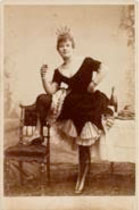
Etienne Carjat
French, 1828-1906
La Goulue, n.d.
albumen print
6 X 4 1/8 in.
SBMA, Museum purchase, Camera Ready Acquisition Funds
1992.62.1
RESEARCH PAPER
This portrait is an abrupt departure from the typical prim and posed portrait of the mid to late 19th century. Louise Weber, better known as La Goulue, or “the glutton” was the most famous and highly paid can can dancer of her day. She would frequently pick up customers drinks as she danced by their table and drain it of its contents, hence the name, La Goulue. She is boldly facing the photographer with a smile on her face, one leg on a chair, with a stack of meat and a champagne bottle behind her. She is holding a class of champagne as if to offer the observer, “cheers”.
Pierre Renoir had become a fan of Ms. Weber’s at the height of her success. He introduced her to his artist friends, one of whom was Henri de Toulouse-Lautrec, who immortalized her dancing at the Moulin Rouge in his posters. The other friend that Renoir introduced her to was Etienne Carjat, who took this albumen print in approximately 1886. Carjat was also an actor, a journalist, and a caricaturist and became known for his simple and incisive portraits of literary and theatrical figures of the time. He was known for his incisive eye, and for capturing the personality and spirit of his subjects. In the context of time, Ms Weber’s pose could be viewed as somewhat shocking, or at least risqué.
Carjat began his photography career in 1855. He made hundreds of cartes-de-viste, which were small calling cards, but his photographs were different than other photographers in that his subjects were shown against plain backdrops to heighten the effect of gesture and expression, as opposed to being posed with pillars and swags of drapery.
The invention of the camera and the photograph was instrumental in changing the art scene forever. There was no way that the artist could compete with the realistic representation of the photograph, so they were free to use their imaginations and go down many different paths of expressing their art. Thus came Impressionism, Abstraction, Cubism, Modernism, and all the other isms that came after the invention of the camera.
The albumen print, which had been invented in 1850, was the most prevalent type of print at the time. The print was made by floating a sheet of thin paper on a bath of egg whites containing salt, which had been whisked, allowed to subside, and filtered. This produced a smooth surface. After it dried, the paper was sensitized by floating it on a bath of silver nitrate solution. The paper was again left to dry, but this time in the dark. This double coated paper was put into a wooden hinged-back frame, in contact with a negative, usually made of glass. It was then placed in the sun to print. The progress of the printing could be checked by carefully opening the back of the frame. It could take a few minutes or up to an hour or more. Once satisfied, the photographer could “fix” the photo by immersing it in a solution of hyposulfite of soda (‘hypo’) and water and thoroughly wash it to prevent further chemical reactions. The print was then hung to dry. Variations in tone and hue were achieved by stopping the processes at different stages and times, or by adding toner. After 1855, they were almost always toned with gold chloride, which enriched their color and increased their permanence, as in this particular photo (Baldwin, 1991, pg 7).
Prepared for the Santa Barbara Museum of Art Docent Council by Leslie Hay-Currie, February 2018
BIBLIOGRAPHY
Baldwin, Gordon, “Looking at Photographs, A Guide to Technical Terms, “British Museum Press, 3rd Printing, 1991.
De Layfayette, Maximillian, “The Rise and Fall of LaGoulue, part 1, Louise Weber, Queen of the Parisian Cabarets, 2nd ed. (New York: Times Square Books, 2011).
Gribble, Frances Henry, “The Origin of the Can Can,” (April 1933) reprinted in Dancing Times (London), October 1990, pp 53-54.
